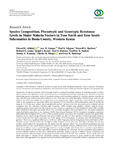| dc.description.abstract | Knockdown resistance (kdr) is strongly linked to pyrethroid insecticide resistance in Anopheles gambiae in Africa,
which may have vital significance to the current increased use of pyrethroid-treated bed net programmes. The study is aimed at
determining species composition, levels of insecticide resistance, and knockdown patterns in Anopheles gambiae sensu lato in
areas with and areas without insecticide resistance in Teso North and Teso South subcounties, Western Kenya. Materials and
Methods. For WHO vulnerability tests, mosquito larvae were sampled using a dipper, reared into 3-5-day-old female mosquitoes
(4944 at 100 mosquitoes per insecticide) which were exposed to 0.75% permethrin, 0.05% deltamethrin, and 0.1% bendiocarb
using the WHO tube assay method. Species identification and kdr East gene PCRs were also performed on randomly selected
mosquitoes from the collections; including adult mosquitoes (3448) sampled using standard collection methods. Results.
Anopheles gambiae sensu stricto were the majority in terms of species composition at 78.9%. Bendiocarb caused 100% mortality
while deltamethrin had higher insecticidal effects (77%) on female mosquitoes than permethrin (71%). Susceptible Kengatunyi
cluster had higher proportion of An. arabiensis (20.9%) than resistant Rwatama (10.7%). Kengatunyi mosquitoes exposed to
deltamethrin had the highest KDT50 R of 8.2. Both Anopheles gambiae sensu stricto and Anopheles arabiensis had equal S allelic
frequency of 0.84. Indoor resting mosquitoes had 100% mortality rate after 24 h since exposure. Overall SS genotypic frequency
in Teso North and Teso South subcounties was 79.4% against 13.7% homozygous LL genotype and 6.9% heterozygous LS
genotype. There was a significant difference (ρ < 0:05) in S allele frequencies between Kengatunyi (0.61) and Rwatama (0.95).
Mosquito samples collected in 2013 had the highest S allelic frequency of 0.87. Discussion. Most likely, the higher the selection
pressure exerted indoors by insecticidal nets, the higher were the resistance alleles. Use of pyrethroid impregnated nets and
agrochemicals may have caused female mosquitoes to select for pyrethroid resistance. Different modes of action and chemical
properties in different types of pyrethroids aggravated by a variety of edaphic and climatic factors may have caused different
levels of susceptibility in both indoor and outdoor vectors to pyrethroids and carbamate. Species composition and populations
in each collection method may have been influenced by insecticide resistance capacity in different species. Conclusions and
Recommendations. Both phenotypic and genotypic insecticide resistance levels have been confirmed in Teso North and Teso
South subcounties in Western Kenya. Insecticide resistance management practices in Kenya should be fast tracked and
harmonized with agricultural sector agrochemical-based activities and legislation, and possibly switch to carbamate use in order to ease selection pressure on pyrethroids which are useable in insecticidal nets and indoor residual spray due to their low human
toxicity. The implication of such high resistance levels in mosquitoes collected in Teso subcounties is that resistance is likely to
persist and or even increase if monomolecules of permethrin and deltamethrin or both continue to be used in all net- and
nonnet-based mosquito control purposes. Usage of mutually reinforcing piperonyl butoxide (PBO) that prohibits particular
enzymes vital in metabolic activities inside mosquito systems and has been integrated into pyrethroid-LLINs to create
pyrethroid-PBO nets is an extremely viable option. | en_US |

